Planning to read aloud to kids in my class is one of my favorite things to do as a teacher! There’s a kind of magic when you read aloud, as students become locked into a good story, or just can’t hold in their responses! However, one thing I’ve noticed in my years as a teacher is that often when we read aloud to kids who are learning English as an additional language, they can struggle to stay engaged and comprehend what we’re reading.
Imagine if you were visiting a foreign country and went to see a movie in the theater…but there were no subtitles. Everyone else was laughing and enjoying the plot twists, but you couldn’t. This is, I imagine, how our English learners must feel as we read aloud to the whole class.
There are numerous ways that read-alouds benefit all of our students. For English learners in particular, they get to hear the pronunciation and usage of English modeled. Also, we build their background knowledge and connect to their prior learning. There are also many cultural connections and new learning that we can invite students into. But…
Without being properly supported by means of instructional scaffolds, or supports, our diverse learners may be left out of the rich experience of our read aloud time. In order to provide equity when we read aloud to kids who are multilingual, we must be intentional in our preparation and presentation of read alouds. Need some practical tips for how to do this? Read on to learn 14 strategies that you can implement in your class!
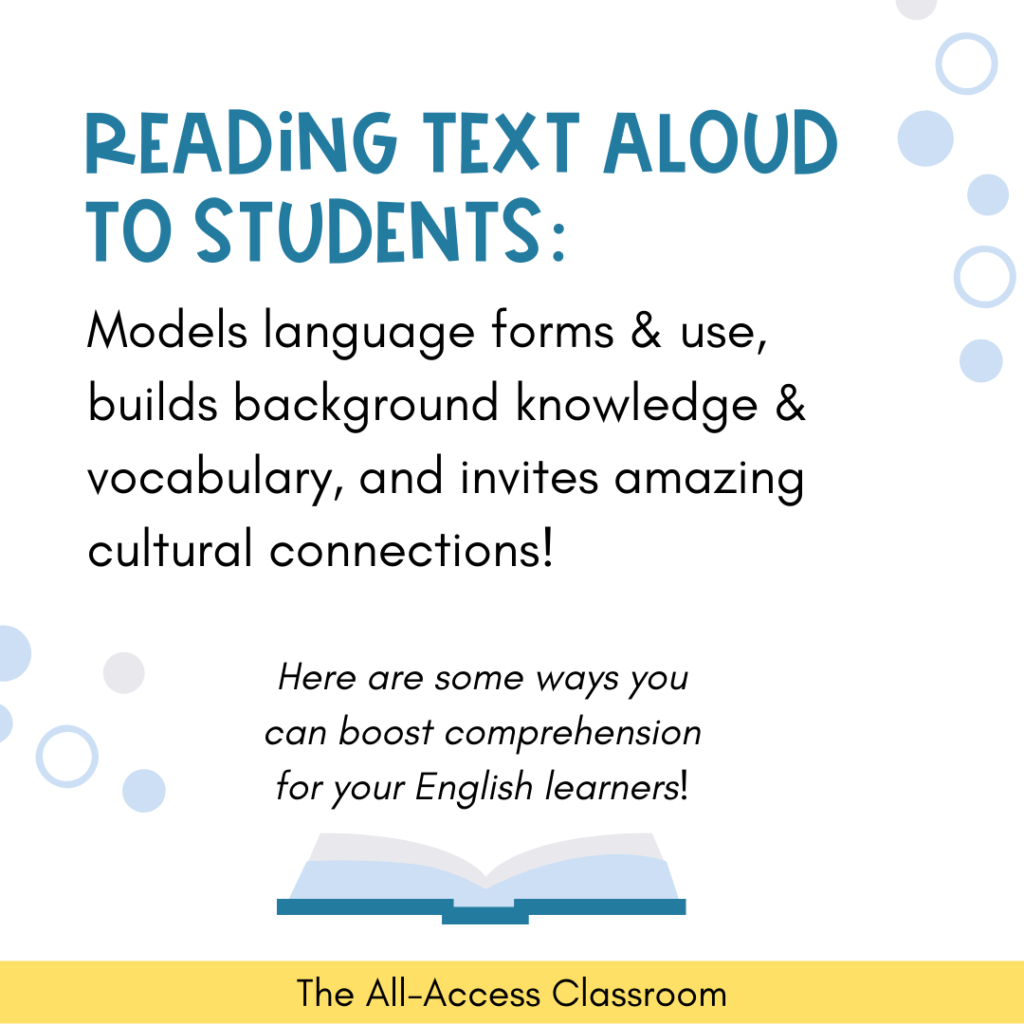
Here’s What Reading Comprehension or Listening Comprehension Challenges to be Aware of as You Plan Your Read-Aloud
Planning for a great read aloud doesn’t need to take super long. Give yourself a few minutes to consider what reading comprehension or listening comprehension obstacles may arise. You know your learners. Hopefully you’re familiar with their English proficiency levels. Here are some ways you can set them up for success:
1. Preview the text for cultural differences that can be investigated & celebrated.
Books are one of the best ways to let your diverse students see themselves represented in the classroom, and also to learn about other cultures. Books serve as “mirrors and windows,” revealing the beauty of our own unique characteristics, and teaching us about those who are different from us. So before you read aloud, think about what cultural differences the text is inviting you to talk about and celebrate with your class.
2. Build/tap into background knowledge.
Your students all come to your classroom with a wealth of prior experiences and understandings. As you prepare your read-aloud, look for ways to connect the text with what students are familiar with. Additionally, you may need to build essential understandings before reading aloud. This may be taking a look at the setting and geographical context of a book. Perhaps it’s painting a picture of the culture or historical timeframe. It might be pointing out something during a text preview that you know the students are interested in.
3. Pre-teach 1-4 key vocab words.
As you pre-read the book yourself, see what “juicy” vocabulary pops up. You don’t need to make a list of every word that may be new to students. (If you introduce too many, students won’t remember the meanings as well.) However, you do want to pull out and pre-teach those words that have a special impact on the story overall. Perhaps it’s a word that shows up multiple times. It could be a term unique to the cultural setting of the book. Maybe it reflects a character’s traits or the theme. To get started, introduce the selected terms’ meanings, along with visual representation and examples.
4. Create an essential question to pose to students.
Plan in advance a higher-order question that elicits critical thinking about an important concept related to the read-aloud. Make it a question that has more than a “yes or no” answer, and challenges students to think and apply new learning. Before reading, write this on the board and introduce it to the class. As you proceed with reading, revisit this essential question. Look for ways it can open up student response and interaction opportunities (speaking and writing).
5. Identify a prominent language element that you can teach (letting the book serve as a mentor text).
Books can provide a context for learning language patterns and forms. Maybe you’re teaching a certain writing or grammar skill as part of your ELA curriculum. Or there may be a feature that you notice appearing frequently in the text, which you can highlight. Plan to do a quick “mini lesson” with the class, explaining the language form. If you can project/display the text for students, teach the form, and give opportunities to practice for themselves.
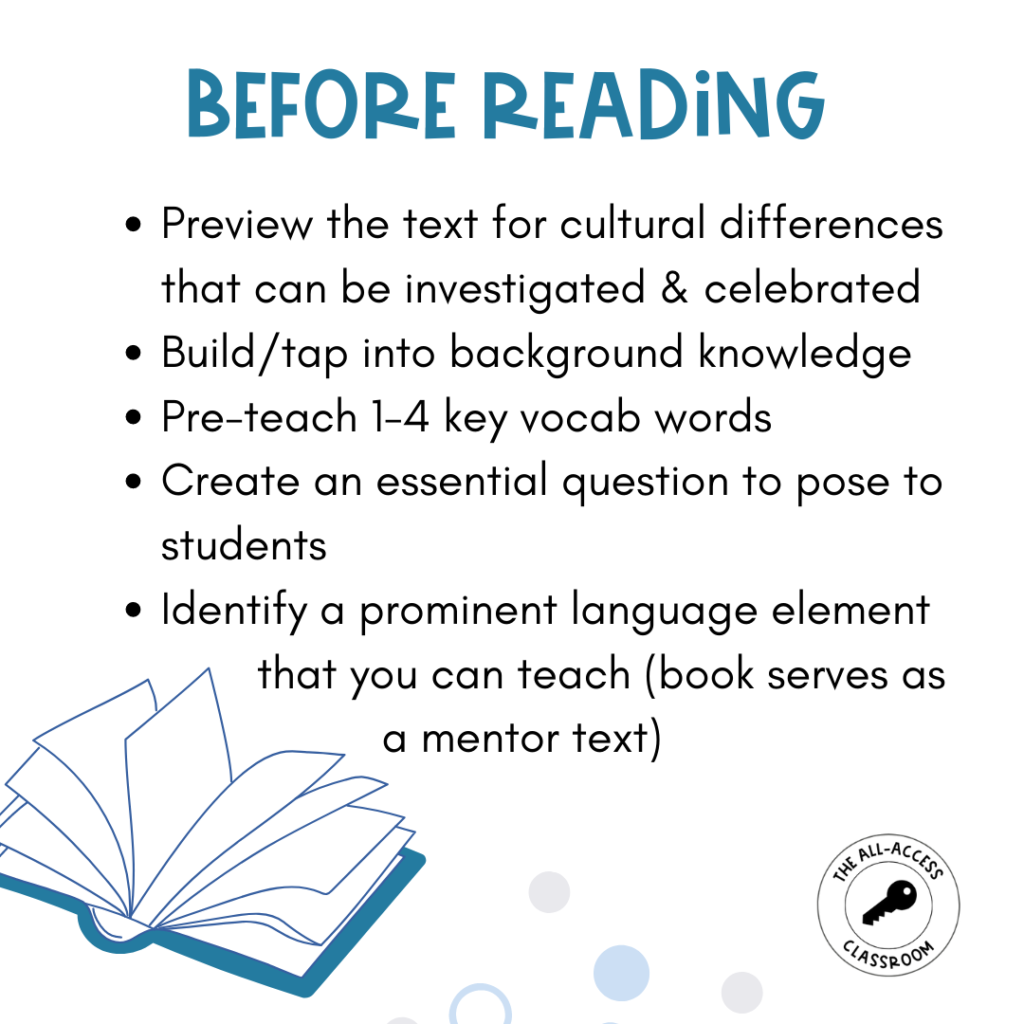
Provide ELL Supports During Your Read Aloud Activity
Now you’ve got the students gathered, and you’re ready to dive in to the read-aloud activity. There is a lot you can do while you’re reading to support English learners’ understanding. The more they understand, the more they will be able to attend and engage. Understanding doesn’t necessarily mean that they need to know every word read. Their overall comprehension can be strengthened as you try some of these supports during the read-aloud activity:
6. Use facial expressions, gestures, & rate of speech to support comprehension.
Sometimes I really get going with a read-aloud and forget to stay conscientious of how my English learners are hearing the words I read. Using character voices are amazing, but can students still recognize words and sounds? Also, how can I use my face, my hands, and my body language to convey meaning?
7. Choral read/echo read parts of text.
One of my favorite techniques is to stop at a new, interesting, or important word/phrase in the text and invite students to “Say it with me.” By engaging their speaking modality in addition to just listening, they are practice pronunciation and fluency! If your text is displayed, you can also have students read along with you an extended portion of text.
8. Model by doing a “think-aloud.”
As students learn new academic language patterns, they need a lot of modeling. When you show them how you think and what you say in response to a text, they become more familiar with various ways we can interact with a text. Stop periodically while reading, to offer an inside look at how you might use comprehension strategies such as questioning, predicting, and approaching unknown words.
9. Offer interaction and response opportunities throughout.
Want to really get students actively engaged in a low-stress way? Give them directed activities and tasks to complete as you read. This could be a “stop and jot,” where you prompt students to write something on whiteboards or in a journal. It may be a “turn and talk” moment. You could co-create an anchor chart, having students contribute to the content, or come up to add sticky notes. These are ways to get students chatting and writing in response to key parts of a read-aloud.
10. Bring in realia that connects with text.
I love a good object lesson. This doesn’t need to be complicated. Bring in a physical object that represents something in the read-aloud. For example, maybe it’s an antique item from the same time period. An article of clothing that holds special meaning for a character. If the characters in the book are preparing for a soccer tournament, use a soccer ball as a “talk tool” during class discussion. This is a great way to tap into your students’ background knowledge and interest!
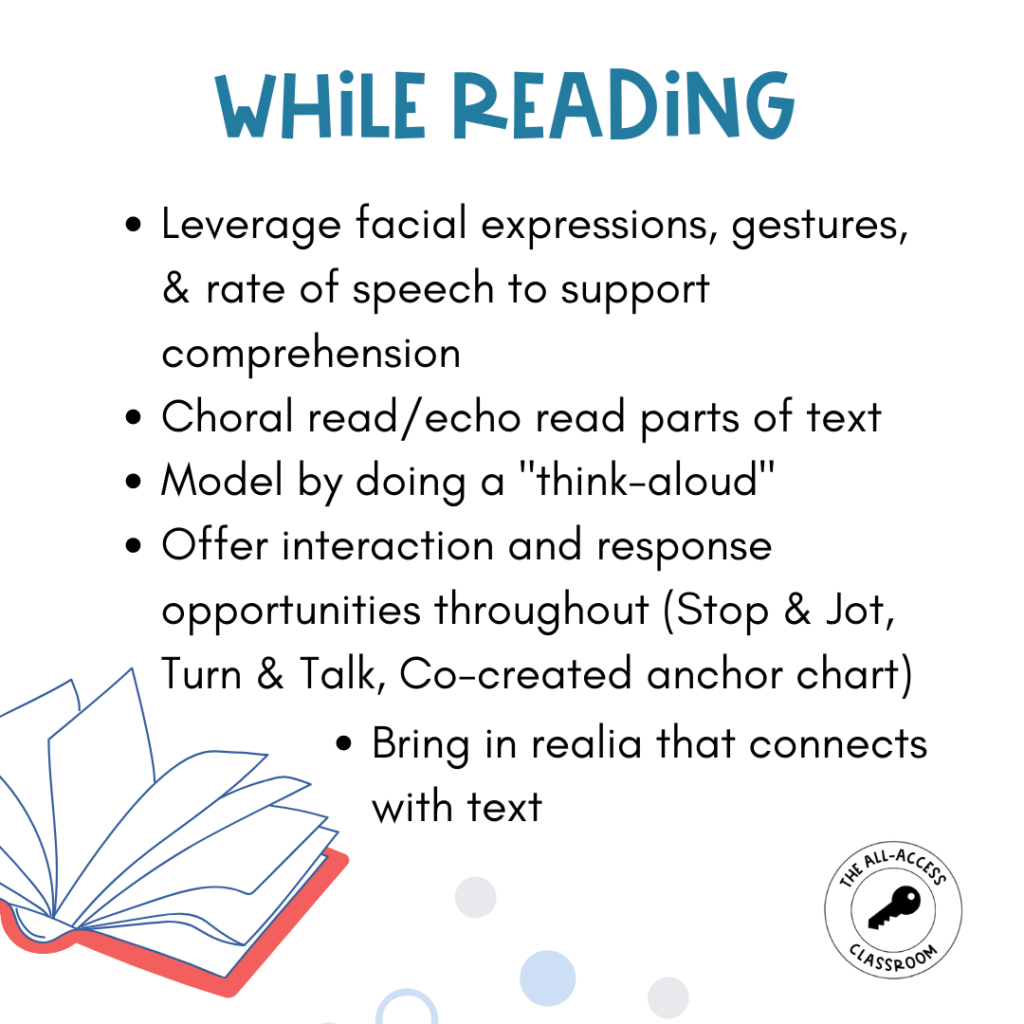
Create a Scaffolded After-Reading Student Engagement Activity
Finally, what you do with students after the read-aloud is so important. It gives them the opportunity to process, reflect, interact with, and apply what they received from the text. As you plan for the read-aloud, consider a student engagement activity that will help your learners connect with the text and move toward your content/language objectives. Here are some after-reading strategies:
11. Allow for supported response activities.
When giving a task immediately after reading, support and scaffold student speaking or writing, as needed. You could give them a writing prompt, and offer your ELs a sentence or paragraph frame to get them started. Provide some accountable talk “moves” to guide them in discussion with a peer. Revisit that essential question, or assess a certain reading skill. Also, this will be a way for you to check-in with students to gauge how well they understood the read-aloud.
12. Record your read-aloud to share with students for repeated listening.
I love this strategy! If you can record yourself reading aloud, either beforehand or while reading to the whole class, you can allow your ELs to view this afterward. Students will see, hear, and practice reading the now-familiar words, in a low-stress context. Depending on the format of the recording, they can pause, slow down, or replay certain parts. Huge language-building activity!
13. Follow-up activity that induces productive language, creativity, individual voice/expression.
Quality read-alouds have a way of touching our heartstrings. As we embrace the characters and learn from their experiences, there is often some personal reflection/connection to be made. Free up some time and space for your students to explore their unique response to the text. This could be a follow-up activity that integrates the arts and invites creativity. Students will feel valued as their voices and experiences are amplified.
14. Use same text again in small group or other setting.
Give students repeated exposure to the text by using it in your small group or other learning contexts. Students will come to the group with some familiarity with the characters, the plot, and the vocabulary. You can give them further opportunities to implement new vocabulary or language forms. They may share their thinking with greater confidence. And in the small group, you can more effectively assess their comprehension. So don’t be afraid to reuse a great read-aloud text!
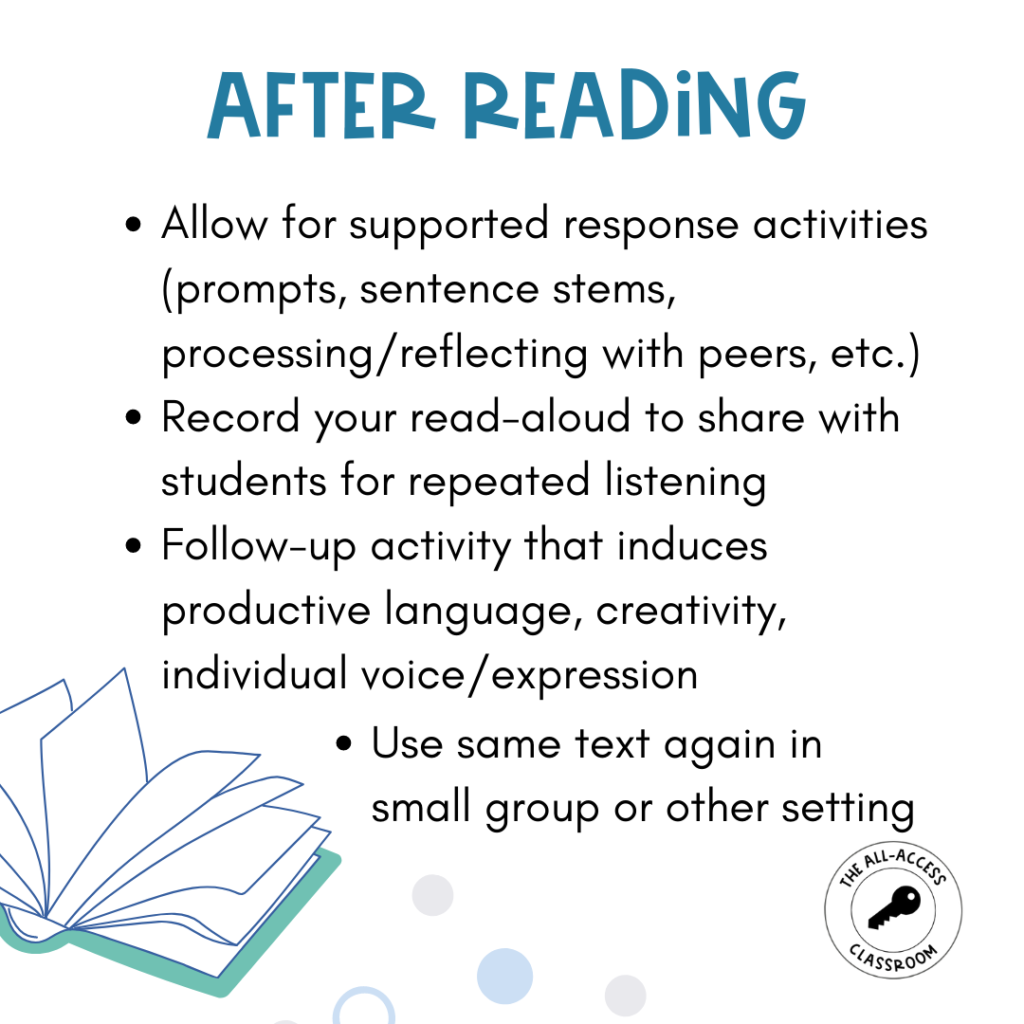
Language Reinforcement Through Read-Alouds
As you can see, our ELs will gain so much through your read-alouds if you add some of these scaffolds. When you read aloud to kids who are growing as multilingual learners, you open doors to new content information. You give them exposure to what English sounds like in different contexts. Their vocabulary and background knowledge increase. There are so many benefits!
In conclusion, the next time you get ready to jump into a new read-aloud book, take a moment to consider ways to support your English learners through the lesson. If you need a tool to guide you as you plan, grab your copy of my content and language objectives template below.
For More On Strategies for Read-Alouds, Check Out:
How to Build a Culturally Inclusive Classroom Library to Embrace Student Diversity – The All-Access Classroom
Revisiting Read Alouds: Instructional Strategies that Encourage Students’ Engagement with Text – Reading Rockets
Teacher Read-Aloud That Models Reading for Deep Understanding – ReadWriteThink
Have fun reading with your kiddos!


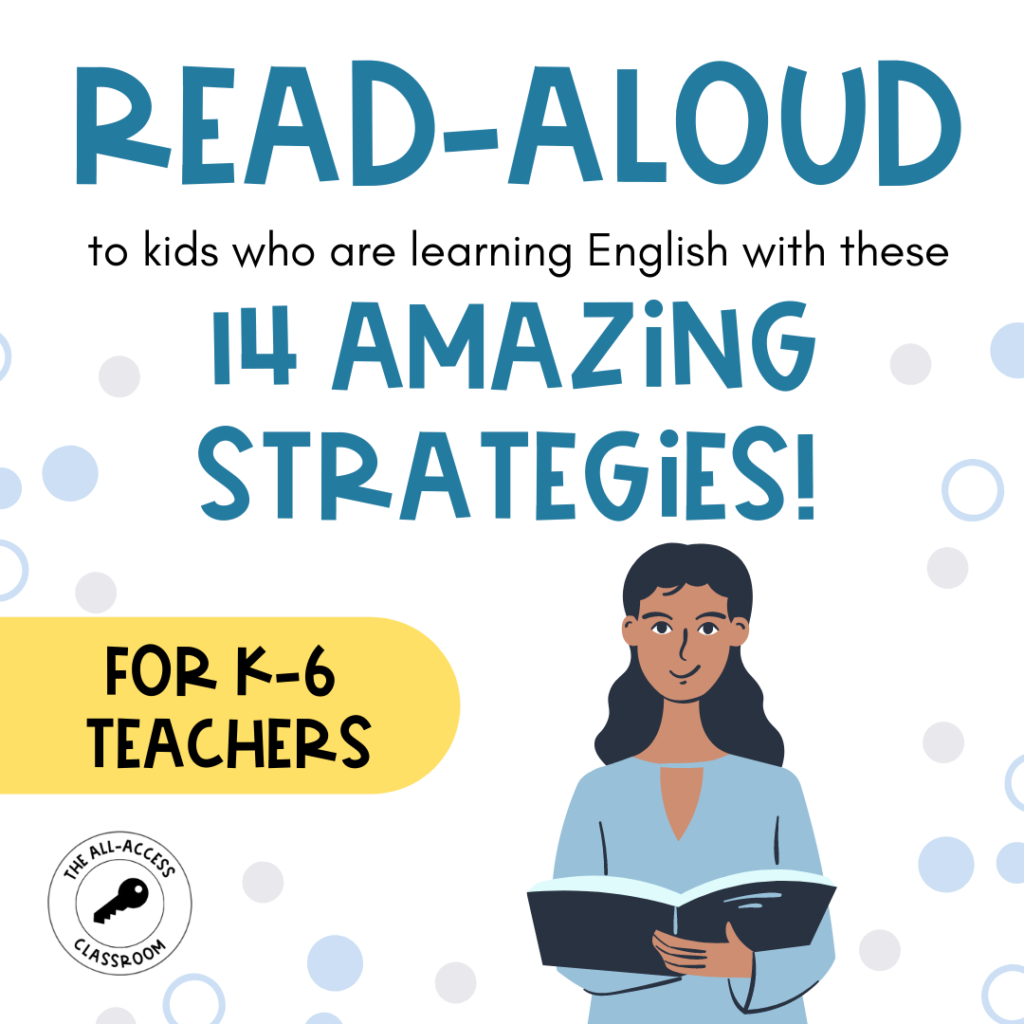

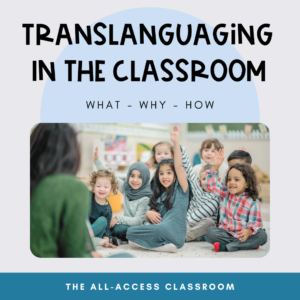


4 Responses
Excellent resources/strategies! I cannot wait to utilize these in my classroom.
Aw yay, thank you so much Alexandra! Happy to help!
Very interesting